1975 United States Grand Prix race report
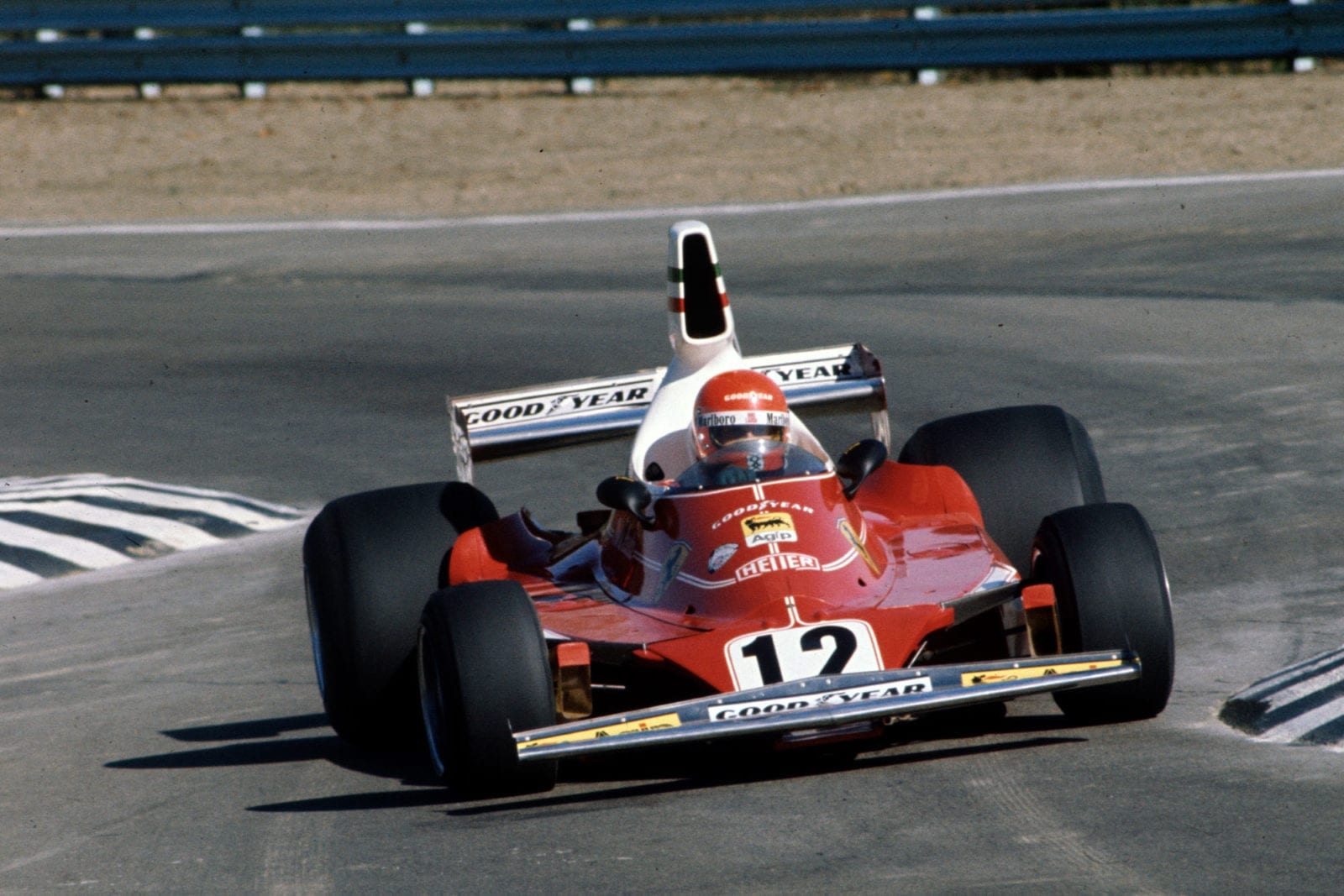
Niki Lauda rounded off the season with a dominant win for Ferrari
Motorsport Images
Lauda rounds it off – Watkins Glen, October 5th
Last year’s United States Grand Prix proved to be a very significant race as it started with Clay Regazzoni, Emerson Fittipaldi and Jody Scheckter all retaining a mathematical chance of winning the World Championship title. In the event, Emerson Fittipaldi became World Champion for the second time by the consistent, rather than spectacular, expedient of finishing fourth, but the organisers at least had the promotional benefit of the Championship struggle continuing all the way to their final race. This year the situation was different. Both Drivers’ and Constructors’ Championships were settled at Monza in September, so the only real interest surrounding the United States Grand Prix was to see whether Niki Lauda had the ability to win at Watkins Glen when he didn’t really have to.
Aggravating the rather lonely and isolated position of this race was the major disagreement between the Formula One Constructors’ Association and the organisers of the Canadian Grand Prix at Mosport Park. Complicated and very acrimonious negotiations throughout the summer had eventually resulted in an ugly impasse at the time of the German Grand Prix, an impasse which couldn’t be resolved even by the Mosport organisers flying to Ostereichring at the time of the Austrian Grand Prix in an attempt to unravel the difficulties. Thus the Watkins Glen organisers were left on their own to finance the transport of Formula One cars from Europe, and the final straw came when the Mosport Park promoters decided to form a company in New York State and obtain a court order against paying out 130,000 dollars of the United States Grand Prix prize fund to the Formula One Constructors. Faced with the prospect of a substantially reduced purse (at least in the short term), there were certain drivers who expressed a marked reluctance towards racing, but fortunately everyone stuck together and yet another potentially ugly scene was successfully “swept under the carpet”.
There were one or two new combinations to be seen in the Watkins Glen paddock, but despite the absence of BRM and Team Surtees, all the familiar faces were present. The fast and demanding, although rather boring, Watkins Glen circuit had been “improved” from a “safety” point of view by the inclusion of yet another ill-considered and badly designed chicane at the approach to the uphill ess-bend where Francois Cevert was killed in practice for the 1973 race. The tight, 3rd-gear chicane with unduly high kerbs and bevelled ridges had been designed after consultation with the GPDA and was to be responsible for a vast number of incidents during the weekend, in which at least three cars were unnecessarily badly damaged. It wasn’t surprising when the GPDA President went to the organiser Mal Currie and asked him for alterations to be made to the chicane; and it wasn’t surprising that the organisers, while they did take out the rather destructive ridges, were not prepared to carry out any more alterations.
Qualifying
Practice took place over the now-standardised two sessions on both Friday and Saturday, and Niki Lauda made it clear that he intended rounding off his Championship season in the best possible fashion by setting the fastest practice lap in all four sessions. By contrast Clay Regazzoni never seemed at home at Watkins Glen, suffering a variety of tyre problems, and the usual band of “doubting Thomases” were in full cry with their suggestions that Lauda’s chassis 023 was superior to Regazzoni’s 024. They went a little quiet in the third session when the new World Champion took out the muletta, 022, and lapped quicker than anyone in the second and third sessions. Regazzoni took over the same machine in the final session and proved unable to lap within a second of his team-mate’s best. Meanwhile Lauda switched back into 023 for the final session and improved to 1 min. 42.00 sec. which left most of his opposition fairly breathless and few people doubting his current form.
Since his determined performance in the Italian Grand Prix, deposed title holder Emerson Fittipaldi seems to have woken up considerably, pitching in against the Ferraris with great verve. At Watkins Glen, where he drove McLaren M23/8, he consistently harried Lauda throughout the two days’ practice. His best time was in the third session, which was 0.36 sec. slower than the Austrian’s Ferrari, sliding the McLaren round from lock to lock with a determination his fans know he is capable of but which he has failed to demonstrate all too often in 1975. To the great encouragement of the Shadow team and Matra personnel present, Jean-Pierre Jarier was fighting hard with the Shadow-Matra V12 during the first session, a revised fuel system and some titanium exhausts from the sports car having endowed it with appreciably improved performance at the top end of its rev. band. Alas, Jarier’s great enthusiasm had to be channelled into the Cosworth-powered DNS after it was calculated that the engine would consume fuel at the rate of 4 m.p.g. under racing conditions, and the French-engined car was sadly pushed away for the remainder of the weekend.
Jody Scheckter and Patrick Depailler both kept up competitively in their French blue Tyrrell-Cosworths during the first session, but there were scowls in the Brabham team as the chicane claimed its first victim and Carlos Pace took BT44B/4 on a spectacular excursion across the kerbing. That was bad enough, but the man who had jostled the Brazilian off the track was none other than his Martini Brabham team-mate Carlos Reutemann! Fortunately the drive back to the pits soothed Pace’s temper somewhat and a hectic confrontation between the two teammates was avoided.
James Hunt had both his regular 308/2 on hand along with the new 308C-type, the English driver trying them both on the first day but delaying a decision as to which one he would use in the race until Saturday. He lapped in 1 min. 45.95 sec. with the older car on Friday afternoon and then spent all his time on Saturday with the C-type, working hard in the first session to pare his times down to 1 min. 43.82 sec., but unable to break into the 1 min. 42 sec. barrier which separated the “heroes” from “the rest”. Running the second works Hesketh 308/3 with private sponsorship, American Brett Lunger was in the team again for his third Grand Prix outing but he got a bit breathless trying to keep up with his much more experienced team-mate.
Team Lotus went through another dismal time during practice, both drivers crashing the underside of their cars over the chicane, and it was hard to realise that only two years earlier Peterson had completely dominated the whole United States Grand Prix weekend. The sole surviving brace of works Lotus 72s, 72/R9 for Peterson and 72/R5 for Brian Henton, were on hand as usual but there was no reasonable hope of them getting close to the front of the grid even if Peterson drove his heart out, so it was wrong to expect very much from his young number two. Another team looking wistfully back into the past must have been the Vel’s Parnelli Jones organisation which have been running a car all year for Mario Andretti. They came in with a big bang in the two North American Grand Prix races of 1974, Andretti qualifying his Maurice Phillippe-designed, torsion-bar Parnelli third fastest at Watkins Glen. Unfortunately, for a vaiety of reasons, this team has not flourished in Europe, but they were back at Watkins Glen this year (doubtless a lot wiser) with a revised chassis (VPJ4/002) for Andretti to drive. Following Lotus’ mid-season lead, they abandoned torsion bars in favour of coil-springs at the rear as well as revising the suspension geometry. Andretti was driving as enthusiastically as ever, perhaps more so as it turned out, for he lapped in a very competitive 1 min. 42.82 sec., which looked good enough for a starting position on the second row of the grid until Reutemann slipped in a spectacular 1 min. 42.68 sec. “flier” shortly before the end of the final session.
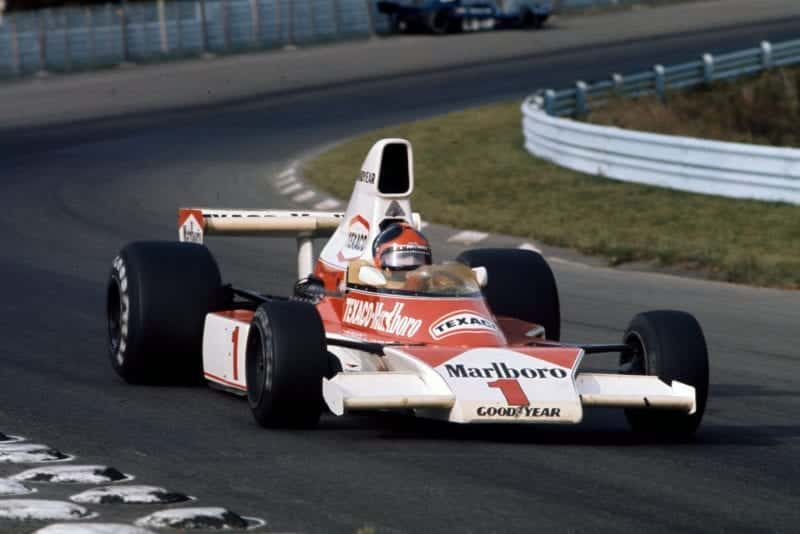
Emerson Fittipaldi put his McLaren second on the grid behind Lauda
Motorsport Images
Both Shadow-Cosworths were pleasing their American sponsors throughout practice, Jarier’s enthusiasm for the Shadow-Matra being carried over into his other car and resulting in a fine 1 min. 42.75 sec., which was good enough for fourth fastest place on the grid. But without doubt the most spectacular performance of the weekend came from the determined Italian Vittorio Brambilla and the mere fact that he qualified his March 751 sixth fastest overall concealed a multitude of problems and drama. Obviously encouraged by establishing the second fastest time behind Lauda’s Ferrari, Brambilla stepped slightly over his personal limit as his orange March went into the braking area for the chicane. The March slid straight on across the kerb before being launched into the air over the rest of the chicane, bouncing down nose-first onto the circuit and then spinning violently round into the catch fencing. Brambilla climbed out shaken but unhurt and the session temporarily came to a halt while the damaged March was extricated from the fencing and returned to the paddock.
Even a cursory inspection of the car was sufficient to confirm that it wouldn’t be practising again on Friday, if at all, but the March mechanics were not going to be defeated by this problem and a firm of aircraft engineers was located at the nearby Elmira airport where they could strip it down to its bare monocoque tub in an effort to prepare it for the race. They worked for almost 36 hours without a break and were still screwing it together on race morning – but their fine display of single-mindedness was rewarded when Brambilla took it out onto the grid and started the race. While the mechanics toiled over his smashed car on Saturday, Brambilla tried out team-mate Hans Stuck’s 751/2 and lapped that in 1 mm. 44.60 sec. on Saturday morning, the German driver making no complaint whatsoever about standing down for that session.
In the Tyrrell camp both Scheckter and Depailler consistently improved during the second day, but Elf March Formula Two driver Michel Leclerc was having a hard job adapting to 460 b.h.p. of a Cosworth DFV after being used to about 280 b.h.p., and the spare Tyrrell was a long way down the field at the end of practice. Making a welcome reappearance after Mark Donohue’s tragic accident at Osterreichring, the Penske team had secured the services of John Watson for the United States Grand Prix and the Ulsterman was having his first race in their brand new PC3 model. Outwardly bearing a strong resemblance to the March 751 which was wrecked in Donohue’s fatal accident, the new Penske has been completely built by the American team at their British base and incorporates the whole rear end of their less than successful PC1 model. A persistent misfire during the final session prevented Watson from improving on his 1 min. 43.31 sec. best which earned him a place on the outside of the fifth row alongside Regazzoni’s tardy Ferrari. In any case Roger Penske seemed extremely Satisfied with Watson’s performance and will almost certainly retain his services for 1976.
Hunt just didn’t seem to be able to get to terms with his new car and the revised circuit, feeling very disappointed at qualifying so far back, while Pace just couldn’t piece a quick lap together and failed to break the 1 min. 44 sec. barrier, let alone the 1 min. 43 sec. barrier. Both Frank Williams’ cars, driven by Laffite and Lella Lombardi, were right at the back after a disappointing practice, the Frenchman driving a new machine dubbed FW/04-2. Lombardi handled the car that Latlite has used all year (now FW/04-1) and both had been rebuilt with side radiators and a full width front wing mounted ahead of a flattened Hesketh-style nose section. Roleof Wunderink took over Mo Nunn’s newest Ensign for another try for Chris Amon had injured his foot in a road accident in California shortly after the previous weekend’s Long Beach Formula 5000 race.
Race
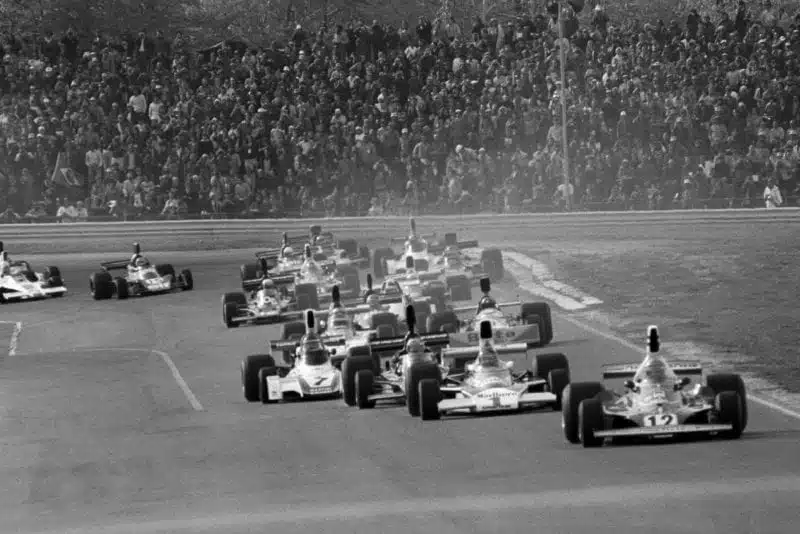
Lauda converts pole into a first-lap lead
Motorsport Images
There were several minor problems during the untimed “warm up” session on race morning with the engine of Pace’s race car turning a little sour and Brise opting to use the older of his two Hill GH1s as he felt the engine in it felt stronger than the one in the race car. At the last minute before the start Watson’s new Penske had another bout of misfiring which meant that the team had to bundle their driver into the waiting car in the pit lane, Watson having not practised in the spare at all during the weekend. Finally neither of the Williams cars managed to get into the race although they had both qualified. Lombardi’s succumbed to a serious misfire on the warming up lap while poor Laffite was rushed off to hospital shortly before the start after inadvertently putting vizor cleaning fluid in his eye rather than the intended eye drops. Fortunately the burns on the front of one eye proved more painful than serious and the Frenchman was fit enough to drive his Martini Formula Two car at Vallelunga the following weekend.
Whilst all this drama was being enacted behind him, Niki Lauda was confidently lined up on pole position and shot straight into the lead as the starter’s flag dropped. The Ferrari easily arrived at the first corner in front of Fittipaldi and, as far as the rest of the field was concerned, that was the last they saw of the two leaders. Refusing to be ruffled by Fittipaldi’s presence right on his tail, Lauda drove coolly and calmly round at the head of the field in a manner that thoroughly befits the World Champion’s status. The McLaren driver was hanging on for dear life in the wake of the Italian car and, equally, had no intention of letting Lauda get away without a fight. By lap five, the leading two cars had left the rest well behind them.
Amongst the “hares” there was plenty of unruly jostling and bumping during those early stages. On the third lap Depailler and Pace tangled on a left-hand corner at the back end of the circuit, the Tyrrell and Brabham spinning into the catch fencing with quite substantial damage to both cars. Further depressing the Tyrrell team, Leclere’s car began throwing out a haze of oil smoke from the time it left the grid and quickly stopped out on the circuit when the oil pressure began to sag after four laps. As if that wasn’t enough, Henton spun his Lotus 72 at the right-hander after the pits, collecting Brise’s Hill in the process, putting the twice World Champion’s protege out of the race with one wheel torn off his car. Pryce’s Shadow quickly made for the pits for a misfire to be rectified and the fourth-place Brambilla soon found himself with an uncomfortable and inconvenient problem as his March’s seat mounting broke and he began sliding around in the car.
In the third place, Jean-Pierre Jarier’s brief spell of good fortune ran out on lap 19 when a wheel bearing started to break up and he was forced to retire his Shadow, but this was nothing compared with the aggravation caused by Regazzoni a lap later as the two leaders lapped the Swiss. Almost predictably, Ferrari’s number two let his team-mate through with no difficulty but then resumed his racing line and steadfastly refused to budge for Fittipaldi. Consequently, Lauda’s lead began to expand dramatically, much to the disgust of Fittipaldi who spent the next five laps or so shaking his fist madly at Regazzoni. Lauda just disappeared into the distance and, before long, it became clear that the organisers were not prepared to put up with Regazzoni’s “team tactics” any longer. Clerk of the Course Bernie Martin hung out the black flag together with number “11” on a board only to be confronted by the rather highly-strung Luca Montezemolo, Ferrari’s team co-ordinator. There followed a rather undignified scuffle, but fortunately things were smoothed over and Montezemolo was identified before the officials threw him out of the pit area and the whole Ferrari team out of the race. Regazzoni came obediently into the pit lane, resumed briefly and then had his car withdrawn from the race on the decision of his team.
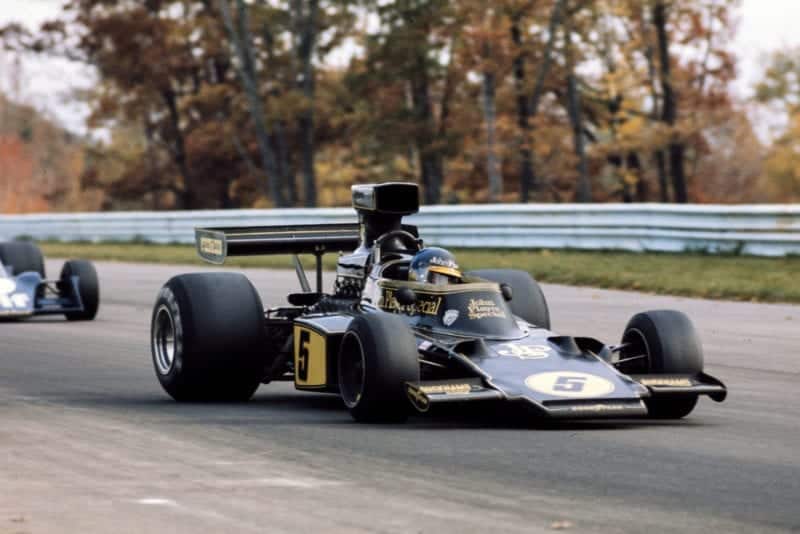
Ronnie Peterson dragged his Lotus up to 5th after starting 14th
Motorsport Images
Lauda’s lead was now secured beyond doubt, thanks to Regazzoni’s “team work”, and we all settled down to watch Fittipaldi try his utmost to get back on terms with the leader. But in reality there had been no necessity for Regazzoni to help his team-mate in so obvious a fashion for Lauda had his immediate opposition well and truly assessed, easing his pace for the last few miles of the 59-lap race to come home the winner by just under five seconds.
Reutemann’s Brabham had retired in the early stages with engine failure, making it a sad day for the team which had dominated last year’s United States Grand Prix and Andretti was doomed from the start, his Parnelli blowing out smoke from the time it left the starting grid. Brambilla couldn’t cope with his March’s erratic handling for 59 laps, the Italian dropping behind Mass’ McLaren, Hunt’s Hesketh, Peterson’s Lotus and Scheckter in the sole surviving Tyrrell. This quartet maintained a tremendous struggle for the balance of the race with Peterson just sneaking past Hunt at the end of lap 49. Unfortunately the Swede had flat-spotted one of his front tyres during his energetic out-braking attempts and Hunt found a gap on the very last lap to take back his fourth place.
Into seventh place came Brambilla’s hardworked March, the battered 751 moving past Stuck after the German had a rear tyre deflate in spectacular style as he went into the right-hander after the pits. Stuck just missed Brise’s abandoned Hill, still lying stranded on the apex of the corner, and was lapped by the leader before he could complete his final lap. Watson finished ninth after a determined performance in an unfamiliar car, Wilson Fittipaldi was tenth and Pryce led Henton across the line to complete the list of competitors still running at the end although they were both several laps down after two pit stops apiece.
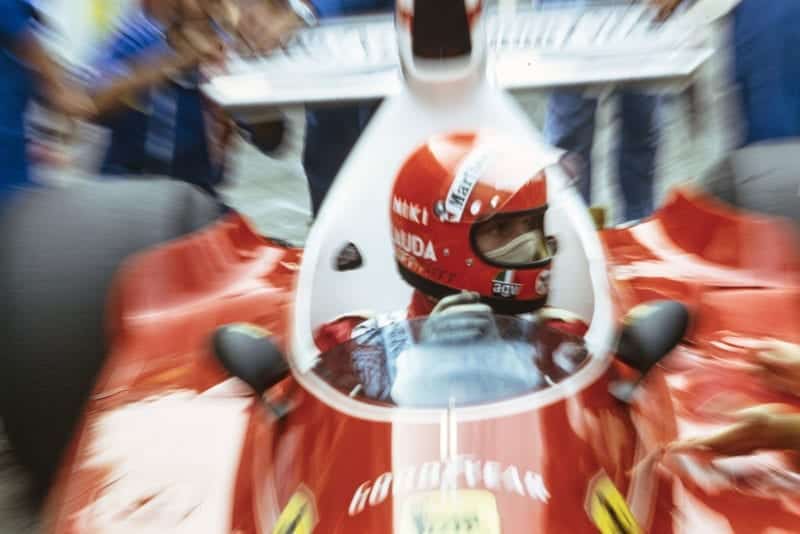
Lauda took win No 5 of the season
Motorsport Images
But for Lauda it was a very complete and worthwhile triumph. In the past so many drivers have clinched the World Championship title before the end of the season only to sit back and “stroke” their way home in the remaining few events. By rounding off his season in such spectacular style, Niki Lauda has managed to add a tag of distinction to his World Championship title, a title too often diminished and diluted by drivers who prefer to drive with Championship points in the forefront of their mind rather than the prospect of winning motor races. – A.H.
